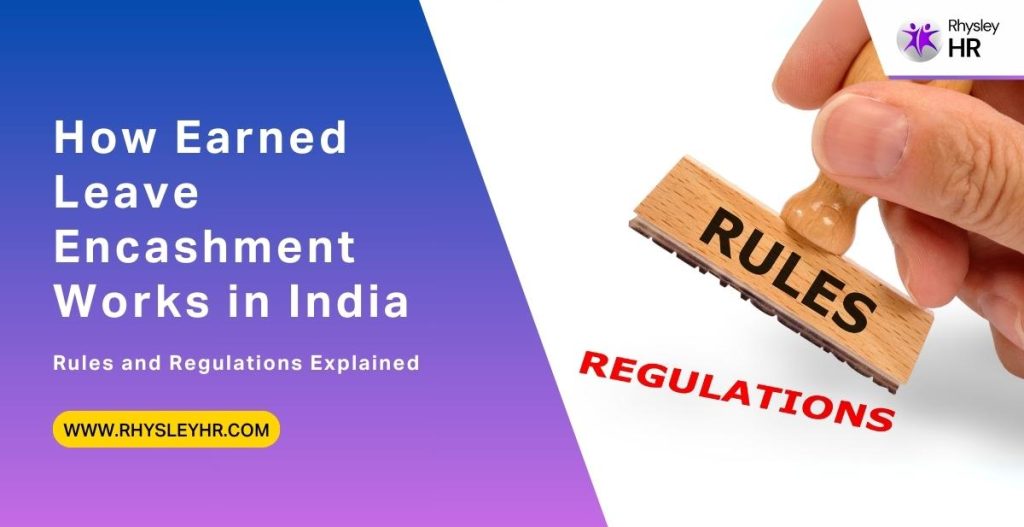Explore all premium features with a 1-Year Free Trial. Schedule your demo NOW!

How Earned Leave Encashment Works in India: Rules and Regulations Explained
Most full-time employees collect earned leave over time. This leave is meant to be used for rest or personal needs. But if some of it goes unused, it can be encashed. This means employees can receive money for those unused days.
What is Earned Leave Encashment?
When employees don’t use all their earned leaves, many companies allow them to exchange those unused days for money. This process is called earned leave encashment in India. It’s common during resignation, retirement, or sometimes while still employed, depending on company rules.
Employees save these leaves over time. Some companies allow them to carry forward a set number of days each year. After a limit, they can request to encash extra days. The rules for this change depending on where the employee works and the policies followed by that company.
Leave Encashment Under Indian Labour Law
Leave encashment under Indian labour law depends on different acts. Government workers are protected by central rules. Private sector employees follow state laws or what is written in their employment contract.
The Factories Act, Shops and Establishment Act, and other regional laws guide these rules. Companies must offer earned leave, and many allow encashment as part of their HR policies. But there’s no one rule that applies to every workplace.
Leave Encashment During Resignation or Retirement
Some employees leave their job without using all their earned leave. In such cases, companies often allow payment for the unused leave. This is common practice in both public and private sectors.
For those asking about leave encashment during resignation in private company, the answer depends on the company’s internal policies. While many provide this benefit, there is no strict law forcing them to. If it’s included in the employment contract or appointment letter, then the employee can claim it.
When someone retires, the rules are a bit more clear. Leave encashment at retirement rules India provide some tax relief and protection. Government employees get full tax exemption on their leave encashment, while private employees get partial exemption based on certain limits.
How is Earned Leave Encashment Calculated in India?
To know how to calculate leave encashment in India, a few basic things are needed. Most companies use a simple formula that is based on the employee’s salary and number of unused earned leave days.
Leave Encashment Calculation Formula
Here’s the standard leave encashment calculation formula:
(Basic Salary + Dearness Allowance) × Number of Earned Leaves ÷ 30
So, if someone has 20 earned leave days and a basic salary of ₹30,000, the calculation would be:
(30,000 + 0) × 20 ÷ 30 = ₹20,000
Some companies may use a 26-day divisor instead of 30. This can change the final amount. Always check how the employer applies the formula.
Read More : What does organization mean?
Tax on Leave Encashment
Leave encashment may be taxed, depending on the case. If encashment is received during service, the full amount is taxable. But during retirement, there are some tax benefits.
Government workers don’t pay tax on leave encashment at retirement. For others, it’s partly tax-free. The law allows a maximum tax-free limit of ₹3 lakh for non-government employees. Anything beyond this is taxed as part of income.
So while planning finances, it’s good to know if the company’s policy falls under leave encashment at retirement rules India or a general policy during service.
Are Private Employees Eligible?
Many ask if private sector employees can also get this benefit. The short answer is yes, but it depends on the employer.
There are no fixed national rules forcing private companies to give leave encashment. But most companies offer it. This is often written in the appointment letter or HR manual. If not, employees may not be able to claim the benefit.
So while there are earned leave encashment rules in India, their application varies from one company to another. Reading company policy carefully is important.
Standard Leave Policy in India
In most workplaces, earned leave builds up monthly or yearly. The number of days allowed differs. For example, some companies allow 1.25 days per month, or 15–20 per year. Many let employees carry over unused leave to the next year, but usually not beyond a limit.
Some companies cap the number of days that can be encashed. Others let employees encash only during certain events—like leaving the job or once a year.
Leave encashment helps employees benefit from unused leave in money form. It’s useful during retirement or job changes. But every workplace applies it differently. Whether in a private company or a government office, checking the company’s leave rules makes things clear.
Knowing the law helps too. Anyone asking about leave encashment calculation, earned leave encashment in India, or the specific earned leave encashment rules in India, needs to look both at the law and at the company policies.
FAQs
Q1. What is earned leave encashment?
Answer. It is a payment given to an employee for unused earned leave. The money is paid when the employee resigns, retires, or as per company policy.
Q2 . How is earned leave encashment calculated in India?
Answer. The most common method uses this formula:
(Basic Salary + Dearness Allowance) × No. of Earned Leave ÷ 30
This shows how the company values each leave day in terms of salary.
Q3. Is leave encashment taxable in India?
Answer. Yes. During service, the full amount is taxed. At retirement, it can be partly or fully exempt. Government workers get full exemption.
Q4. Are private company employees eligible for leave encashment?
Answer. Yes, if it is included in their company’s policy or employment contract.